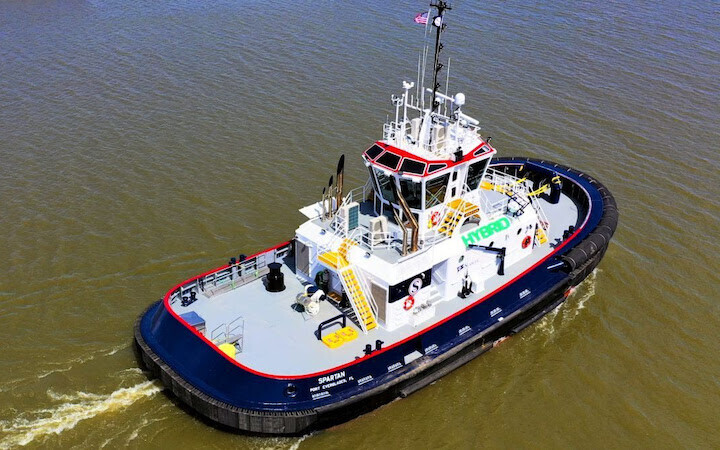Tugboat designs continue to evolve with an emphasis on propulsion efficiency coupled with improving onboard working conditions.
The commitment to hybrid-electric propulsion units is growing after a slow start due to the technology’s capital cost.
It’s “picked up quite heavily with more hybrid tugs and battery-electric tugs,” said Lawrence Best, director of design development at Robert Allan Ltd., Vancouver, British Columbia.
An example is the Robert Allan- designed 98'6"×43'×17'6" Seabulk tug Spartan, which operates in Port Arthur, Texas. The Spartan is powered with a Berg Propulsion package comprised of twin 2,550-hp Caterpillar 3512E main engines matched up with twin Cat C18s generators and one Cat C7.1 generator, enough power to generate 12.6 knots running speed. The Spartan was built by Master Boat Builders, Coden, Ala., and was said to be “the most advanced hybrid electric package ever delivered by Berg Propulsion.”
The 5,100-hp Spartan runs on main engines only, gensets only or a combination. Switching from one operating mode to another is accomplished by pushing a button. In hybrid mode, power is balanced between diesel and electric motors to optimize fuel consumption and bollard pull.
Daniel Thorogood, Seabulk president and CEO, said the Spartan represents “a new generation of vessels whose flexibility is proving that hybrid tug technology is our choice for the future.”
ELECTRIC TUG
Not to be outdone is Crowley Engineering Services, Seattle (formerly Jensen Maritime Consultants), which oversees construction of a vessel that has the attention of most of the tugboat industry. It’s the eWolf, which will be the first fully electric ship-assist tug in the U.S. and is designed to be the first zero-emission tugboat. Small gensets will be available if needed, but the eWolf is expected to operate primarily on batteries that are recharged at night at a dock in San Diego. The 82'×40' harbor tug was designed by Crowley Engineering and is being built at Master Boat Builders, Coden, Ala., for Crowley Marine Services.
When it comes to improving energy efficiency and reducing greenhouse gases, the American Waterways Operators emphasized in a memo to its members that based on empirical data, the tug, towboat, and barge industry “is the most environmentally friendly, fuel efficient mode of freight transportation, with both lower greenhouse gas emissions per-ton-mile and a substantially smaller carbon footprint than competing modes.”
On another design level, the eWolf, with a projected 70-ton bollard pull, will be the testing platform for some of Crowley Engineering’s next-generation tugboat designs. As fuel efficient and powerful as a tug might be, if the crew doesn’t like the living and working conditions, some of them might not stick around for any length of time, and suddenly the tugboat operator finds itself shorthanded.
Thus, an important eWolf design focus is an emphasis on crew comfort that aims to provide “people their own personal space that can be uniquely updated for each person on the vessel, to give us a completely fresh look inside the vessel to anyone stepping on aboard,” said Bryan Nichols, director, business development, Crowley Engineering Services. Elements in that design were arrived at after Crowley engaged noise consultants and interior designers and sent engineers out on vessels to understand what life is like on a tugboat.
Other eWolf innovations include the bow staple, which is pushed into the bulwarks to keep crewmen from getting caught between the staple and the line going out to a ship, and a step that’s been traditionally in the deck was eliminated. Perhaps the most innovative feature is a rescue ladder built into the port and starboard sides of the tug, about amidships, making it much easier for someone who falls overboard to haul himself back aboard. The eWolf is scheduled to be operational in 2023. But even before it’s been launched there’s already talk that the next eWolf generation will have a 90-ton bollard pull.
Nevertheless, there does continue to be plenty of demand for more conventionally powered tugs. That includes the Robert Allan-designed, 77' Athena, a Tier 4 ship assist and harbor escort tug for Brusco Tug & Barge, Longview, Wash. It was built at Diversified Marine, Portland, Ore., and outfitted with a pair of 3,400-hp Caterpillar 3516 Tier-4 compliant engines generating 96 tons of bollard pull. Crowley Maritime chartered the tug and claimed it is “the most powerful tug for its size in the U.S.” The Athena also came with remote monitoring.
Main Iron Works is building a 5,000- hp tractor tug for Bisso Towboat at its Luling, La., shipyard to be powered with a pair of 2,500-hp Caterpillar 3516E diesels. The estimated bollard pull will be 66 tons. This will be the sixth azimuth stern drive (ASD) tractor tug Main Iron has built for Bisso in the past nine years. The previous one was the 100'×38'×13'6", 6,008-hp Capt. Joseph Bisso delivered in early 2022.
Master Boat Builders will build its first tugs for Moran Towing, New Canaan, Conn. The 86'×36' tugs will have a bollard pull of over 55 tons, and each will be outfitted with twin Caterpillar 3512E main engines, producing 2,549 hp each. The tugs will also feature Kongsberg thrusters and a Markey Machinery bow winch.
The Army Corps of Engineers will increase its presence on the Great Lakes with a pair of 1,600-hp 76'×25'×10'8.5" CELRE Detroit ice-class tugs to be designed and built by Conrad Shipyard, Morgan City, La.




